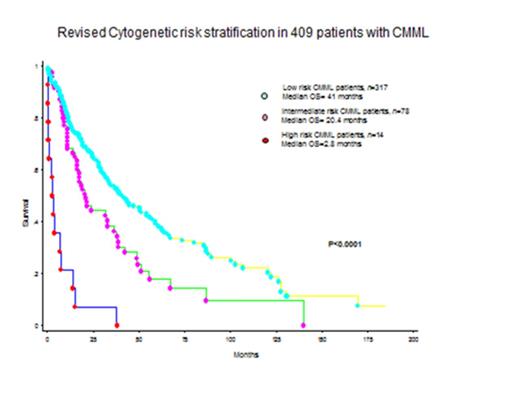Abstract
Background:
The prognostic significance of cytogenetic abnormalities in chronic myelomonocytic leukemia (CMML) was recently revisited (AJH, 89; 813-818, 2014 and Blood April, 2013). Using a large Mayo Clinic-French Consortium database, we analyzed the molecular and prognostic correlates of cytogenetic abnormalities in CMML.
Methods:
CMML diagnosis was according to World Health Organization criteria. Cytogenetic analysis and reporting was done according to the International System for Human Cytogenetic Nomenclature. Statistical analyses considered clinical and laboratory parameters obtained at time of cytogenetic studies.
Results:
Spectrum and frequency of cytogenetic abnormalities: A total of 409 patients participated in this study including, 268 (66%) from the Mayo Clinic and 141 (34%) from the French CMML consortium. Of these, 396 (97%) had ≥20 metaphases and 13 (3%) had ten to 19, analyzed. One hundred and fifteen (30%) patients displayed an abnormal karyotype, including 82 (71%) sole, 20 (17%) two and 13 (11%) complex abnormalities. The most common abnormalities were; +8 (23%), -Y (20%), -7/7q- (14%), 20q- (8%), +21 (8%) and der (3q) (8%). Other cytogenetic abnormalities included 5q-, 12p-, 13q- and i(17q), present at a much lower frequency (0.9-4%).
Phenotypic correlates: Abnormal vs normal karyotype was associated with older age (p=0.03), hemoglobin<10 g/dL (p=0.0009), white blood cell count (WBC) >15 x 109/L (p=0.02), absolute neutrophil count (ANC) >10 x 109/L (p=0.03), absolute lymphocyte count (ALC) >2.5 x109/L ( p=0.04), peripheral blood (PB) blast ≥1% (p<0.0001), bone marrow (BM) blast ≥10% (p<0.0001) and circulating immature myeloid cells (IMC) (p=0.0003). +8 (p=0.01), +21 (p=0.03) and der (3q) (p=0.03) were associated with hemoglobin <10 g/dL. -Y was associated with older age (p=0.04), lower PB (p=0.04) and BM (p=0.02) blasts. -7/7q was associated with leukocytosis (p=0.005), neutrophilia (p=0.04), and higher PB blasts (p=0.004). 20q- was associated with thrombocytopenia (p=0.04).
Molecular correlates:ASXL1 mutations were associated with abnormal karyotype (p=0.04) and SRSF2 with normal karyotype (p=0.02). In comparison to other abnormal karyotypes, the incidence of ASXL1 mutations was lower in –Y (P=0.04) and der(3q) (p=0.03). U2AF1 mutations were associated with monosomal karyotype (p=0.03) and SF3B1 with der (3q) (p<0.0001).
Prognostic relevance: Median follow-up was 1.8 years with 244 (60%) deaths and 79 leukemic transformations (19%). A step-wise survival analysis resulted in three distinct cytogenetic risk categories (Figure 1): high (complex and monosomal karyotype), intermediate (all abnormalities not in high or low risk) and low (normal, sole -Y and sole der (3q)); the corresponding median survivals were 0.2 (HR 8.1, 95% CI 4.6-14.2), 1.7 (HR 1.7, 95% CI 1.2-2.3). In multivariable analysis, the particular cytogenetic risk stratification remained significant in the context of Mayo molecular model (p<0.0001), MDAPS (p<0.0001), and the GFM risk model (P<0.0001). The Mayo-French cytogenetic risk model was also effective in predicting leukemic transformation with HR of 10.9 (95% CI 4.2-27.8) for high and 2.2 (95% CI 1.3-3.7) for intermediate risk groups.
Conclusion:
Cytogenetic abnormalities are seen in approximately 30% of patients with CMML and display significant associations with certain molecular and phenotypic characteristics. We describe a novel cytogenetic prognostic model for both over-all and leukemia free survival in CMML.
No relevant conflicts of interest to declare.
Author notes
Asterisk with author names denotes non-ASH members.


